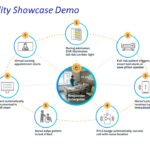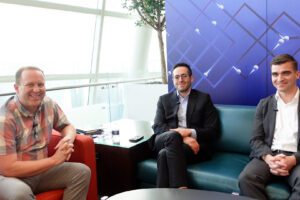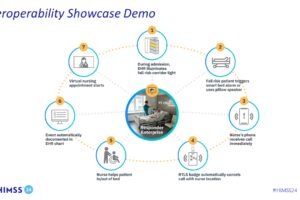The following is a guest article by Kim Howard, Chief Client Officer at Nomad Health
The U.S. healthcare system faces an estimated national deficit of more than 900K registered nurses by the end of the decade. Hospital CEOs agree that workforce challenges are the biggest issue they face, with 90% saying nursing shortages are the most pressing – a trend driven by the 4.7M healthcare workers retiring by 2030. The “silver tsunami” is also to blame, with 10K baby boomers aging into Medicare coverage daily, placing even further strain on the situation.
Fewer nurses, a slowed education pipeline, and more patients in need of care certainly do not bode well for fixing this shortage, making the industry desperate for solutions. But merely recognizing the clinician shortage barely begins to scratch the surface of a much deeper problem plaguing healthcare: burnout, which only exacerbates job dissatisfaction. McKinsey recently released a report that revealed that 45% of inpatient nurses – nearly half of the 4.2 million nurses in the U.S. – “are likely to leave their role in the next six months.”
While the thought that almost half of American nurses are trying to leave their positions could lead hospital executives to panic, there is room for optimism. Yes, many nurses are retiring, overworked, and burned out as the industry continues to right itself following the pandemic. While many nurses do report they intend to leave their position, they should be aware that other options are available to them, including travel nursing, where data shows that 76% of those in that field express satisfaction with their jobs.
Challenges
For many caregivers, it’s considered a calling rather than a profession. As such, nurses long held high career satisfaction rates until COVID-19 upended the field. The fallout of the pandemic was so traumatizing and disruptive to normal operations that many clinicians lost all sense of direction over their careers. To turn things around and alleviate the shortage of RNs threatening the stability of the healthcare system, clinicians need more control over their professional journeys.
For many, a considerable benefit of travel nursing over a staff position is that it allows one to avoid workplace politics that can be burdensome to clinicians, further contributing to burnout.
Digitizing Recruitment
Staff turnover has destabilized the industry, and reverting to out-of-date staffing tactics will not solve the problems. Clinicians know what jobs they want. They understand their skills and expertise better than anyone. Traditional travel recruiters, on the other hand, are tasked with selling a single job to multiple clinicians without putting much thought into whether that position is the best match. If hospitals want to mitigate staff burnout, they need to hire people quickly, and the best way to do that today is with technology.
Technology, such as online staffing platforms, allows clinicians to take control over their professional journey. It creates the ability for them to self-review job postings and set personal preferences and rules based on their specific skills and interests. Being able to find a position that matches these immediately increases the likelihood that both the clinician and the facility will gain satisfaction and success from the match.
For example, a recruiter trying to push a NICU nurse into a med-surg job immediately sets them up for probable failure. Rather than helping them operate at the top of their license, it’s putting unfair pressure on them and further contributing to the burnout problem. Similarly, if a clinician is hoping for a job in California, and they’re instead sent to South Dakota to fill a role at a hospital in which they’re not interested in working, that’s exacerbating clinician burnout and setting the facility up for a greater risk of cancellation.
With digital staffing solutions, hospitals can guarantee their job postings reach thousands of the most qualified and interested candidates, which speeds up the hiring process. Using a machine learning model, combined with clinician preferences, to inform who can see and apply for jobs ensures a better match. It increases the likelihood of hiring a clinician who is excited about their position, which in turn, encourages them to operate at the top of their abilities. By giving job-seekers control over which jobs they apply for, it builds a culture that fosters staff confidence and prioritizes delivering the best care for patients.
Welcoming the Next Generation
Today’s nurses are coming from an educational environment where technology is central to their learning process. Students study on iPads, learn to read data analytics, and use digital applications in their courses. Not only were they taught with technology, they grew up with it. Smartphones, tablets, and apps that enable everything from grocery shopping to booking a trip with just a few clicks have raised a generation of digital natives who are already savvy and knowledgeable on how to use technology to make all aspects of lives easier and more productive.
They are often trained in a completely technology-based lab rather than on cadavers. When they leave school, they’re naturally predisposed to seek out similar, tech-oriented environments, a factor with which hospitals and health systems using outdated recruitment tactics must reckon.
Staffing for the Future
Newly graduated nurses are drawn to technology because it’s an extension of not just what they have already been taught, but their lives in general. Enter online staffing platforms. Unlike traditional methods such as phone screenings, these application processes meet nurses where they are, offering recorded interviews that hiring managers can watch on-demand, ultimately speeding up the recruitment process and getting clinicians to the bedside faster.
Healthcare is adapting to the use of technology at the center of patient care, including how clinicians are recruited, ultimately decreasing the time it takes facilities to secure an experienced, qualified clinician to ensure patient/staff ratios are manageable. More than that, it is also allowing clinicians to take control of their careers and find positions where they can learn, grow, and succeed with confidence. Healthcare is amid an industry-wide sea change whether it’s wanted or not. In order for hospitals to have adequate staffing for increasing patient populations, they need to embrace innovation from the top down and put clinicians in the driver’s seat.
 About Kim Howard
About Kim Howard
Kim Howard, Nomad Health Chief Client Officer, brings 25+ years of staffing industry experience, with 18 years focused entirely on the healthcare market. With prior experience at AMN and Nursefinders, Kim is passionate about providing clinicians with the tools, information, and support they need so they can find the most rewarding assignments with as little effort as possible, allowing them to do what they love the most – focus on their patients.













